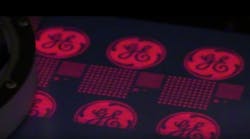There have been alternative technologies for indoor displays proposed in past research studies, with a focus on the disadvantages of viewing angle in common LED display architectures. This article proposes a new method for improving LED display quality by increasing the fill factor on the basis of analyzing the black area in the basic physical structure of common LED display applications.
Black area
The typical composition of an LED display panel is an array of single discrete pixels. Inevitably, there exist black areas between the individual pixels in an array composition. The example shown in figure 1 can be analyzed to show what impact black area plays on display quality.
Figure 1 shows a typical pixel configuration of a 10 mm-pitch SMT full-color LED display panel. The total surface area of each pixel is 100 mm2. Red, green and blue colors are produced respectively by SMT LEDs, each having a light-emitting area that is a 2.2mm diameter round dot with an area of 3.8 mm2.
Since there are times when only one LED chip gives off light in a normal display operation, the minimum fill factor F = 0.038 (i.e. 3.8/100).
Similarly, the remaining area of the pixel, i.e. the black area that does not give off light, is equal to 96.2mm2 (i.e. 100-3.8).
A black area of this size would significantly hurt the imaging quality of an LED screen viewed at a normal viewing distance. It has been established that the fill factor should not be lower than 0.5, while the value of the example given above is much lower. The average diameter of black area far surpasses the pixel pitch, consequently posing a distinctively negative factor on imaging quality.
Minimum viewing distance
According to the definition of human eye resolution ability, the perception angle of a normal human eye under medium brightness conditions is approximately 1-1.5 minutes. Based on these angles, a list of minimum viewing distance for various pixel pitches can be compiled as shown in Table 1.
******Table 1******
Pitch: 4.76 mm Minimum viewing distance: 11-16 m (average = 13.5 m)
Pitch: 6.35 mm Minimum viewing distance: 14.5-21.8 m (average = 18.2 m)
Pitch: 10 mm Minimum viewing distance: 23-34 m (average = 28.5 m)
Pitch: 11.43 mm Minimum viewing distance: 26.2-39.3 m (average = 32.8 m)
The minimum viewing distance means that the observer will not see a collection of individual pixels.
******Table 1******
Within the distances listed in Table 1, an observer can view the individual pixels easily and clearly. In the previously analyzed example, one needs to stand more than 23 meters away to view the image without seeing a collection of individual pixel dots. We can also find in Table 1 that the minimum suitable viewing distances are far larger than that of actual LED display observation, despite the fact that those figures have been conservatively estimated.
Of course, a shorter minimum viewing distance can be achieved with a smaller pixel pitch. However, this approach often means more LEDs per unit area, and consequently higher cost. A common solution for this dilemma is to make the system minimum viewing distance as close as possible to the actual viewing distance desired by the customer.
Another less favorable factor is that observation frequently takes place within the minimum viewing distance, which in turn makes the black area even more prominent.
Similarly, color blending quality is another outstanding disadvantage of LED displays. Because the minimum viewing distance is too large for ordinary observers and many observations have to be carried out within this distance, the color blending quality would become another distinct problem. This is particularly true with displays using the Visual Pixel technique, in which the LEDs are deliberately deployed with much larger inter-pixel spacing.
High fill-factor solution
The purpose of this article is to suggest a high fill-factor technique for LED displays, which could overcome the visual quality issues studied previously i.e. unduly large black area, LED flaring, color blending problems, and other factors arising from the large minimum viewing distance.
This high fill factor LED display system features enlarged bring area surface for each pixel using a reflection chamber that covers all the LED chips (see figure 2).
The top of the chamber is a rounded square in shape. The bottom is in contact with the LED chips, and takes an even more rounded square shape. In this design, the dimension of the bright area is determined by the area of the top section of reflection chamber. Clearly, the average diameter of the black area (between the borders marked 1 and 2 in figure 2) is much smaller than the pixel pitch.
Again using the example of 10 mm pixel pitch, let's take 0.5 mm as the minimum spacing from the border of the bright area to the border of the pixel, i.e. the distance between neighboring bright areas within adjacent pixels is 1mm. The bright area (border marked 2 in figure 2) may be as large as 80mm2 ,making the fill factor as high as 0.80.
The color blending quality is also dramatically improved in this design as all LEDs within the pixel are included in the same chamber. Adding a certain amount of mixer additive into the chamber may further improve blending quality.
Another benefit associated with higher fill factor is that the uncomfortable glaring effect no longer exists. This makes it possible to improve LED visual quality by increasing the LED's light output. The color distortion problem caused by high operating temperature could be avoided by using a 3-dimensional heat sinking technique that effectively reduces heat accumulation within the display panel.
Discussion
A lens system could also be considered in order to increase the fill factor. The major disadvantage of the lens method lies in the visual quality. Due to the inherent optical character of a lens, the pixel would yield a 10-30% inconsistency when viewed at different angles. This inconsistency would be intolerable for any observer. Also must be taken into consideration is that the impact of lens system on viewing angle would hurt visual effect of the LED system considerably.
Color blending: although it is reasonable to position all basic colors into the same bright area, there is one point to be remembered in the using of mixer additive. Adding mixer additive might block off part of the light out put of LEDs, so the amount must be carefully calculated with full consideration on factors like pixel size, fill factor and chip configuration.
Heat sinking is another significant element in LED display applications. If heat accumulation is not handled properly, the equipment might tend to be damaged by high operating temperature, with a resultant decrease life and output. An even more serious consequence is that LED color might be changed by high temperature in terms of brightness level and/or wavelength, leading to display imaging inconsistency.
The performance of an LED display system relies on its visual quality. Fill factor, and issues relevant to fill factor, are among the key factors to be resolved besides general structure, uniformity, video signal processing, luminance and resolution.
Conclusion
In conclusion, a high fill-factor LED display system has the following outstanding advantages of:
* Eliminating the negative impact of black area
* Eliminating the LED glaring effect, thus making it possible to upgrade LED panel brightness level
* Providing better color-blending quality
* Providing better uniformity and wider viewing angle









